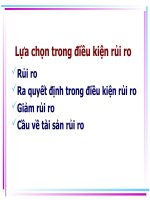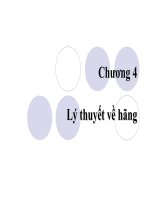- Trang chủ >>
- Đại cương >>
- Kinh tế vi mô
Monopolistic competition (KINH tế VI mô SLIDE)
Bạn đang xem bản rút gọn của tài liệu. Xem và tải ngay bản đầy đủ của tài liệu tại đây (506.54 KB, 13 trang )
Microeconomics
Chapter 6
Part 3: Monopolistic
Competition
1
The four types of market structure
Economists who study industrial organization divide markets into four types:
monopoly, oligopoly, monopolistic competition, and perfect competition.
2
2
Between Monopoly & Perfect
Competition
Monopolistic competition
Many sellers
Product differentiation
Not price takers
Downward sloping demand curve
Free entry and exit
Zero economic profit in the long run
3
3
Competition with Differentiated
Products
Monopolistically competitive firm in
short run
Profit maximization
Quantity: marginal revenue = marginal
cost
Price: on the demand curve
If P > ATC: profit
If P < ATC: loss
4
4
Monopolistic competitors in the short run
(a) Firm makes profit
(b) Firm makes losses
Price
Price
MC
ATC
Price
MC
ATC
ATC
Price
ATC
Profit
Demand
Losses
Demand
MR
0
Profitmaximizing
quantity
MR
Quantity
0
Lossminimizing
quantity
Quantity
Monopolistic competitors, like monopolists, maximize profit by producing the quantity at which
marginal revenue equals marginal cost. The firm in panel (a) makes a profit because, at this
quantity, price is above average total cost. The firm in panel (b) makes losses because, at 5this
quantity, price is less than average total cost.
5
Competition with Differentiated
Products
The long run equilibrium
If firms are making profit in short run
New firms - incentive to enter the
market
Increase number of products
Reduces demand faced by each firm
Demand curve shifts left
Each firm’s profit – declines until: zero
economic profit
6
6
Competition with Differentiated
Products
The long run equilibrium
If firms are making losses in short run
Firms - incentive to exit the market
Decrease number of products
Increases demand faced by each firm
Demand curve shifts right
Each firm’s loss – declines until: zero
economic profit
7
7
A monopolistic competitor in the long run
Price
ATC
MC
Price = ATC
MR
0
Profit- maximizing
quantity
Demand
Quantity
In a monopolistically competitive market, if firms are making profit, new firms enter, and the
demand curves for the incumbent firms shift to the left. Similarly, if firms are making losses, old
firms exit, and the demand curves of the remaining firms shift to the right. Because of these
shifts in demand, a monopolistically competitive firm eventually finds itself in the long-run
8
equilibrium shown here. In this long-run equilibrium, price equals average total cost, and the
8
firm earns zero profit.
Competition with Differentiated
Products
The long run equilibrium
Zero economic profit
Demand curve
Tangent to average total cost curve
At quantity where marginal revenue =
marginal cost
Price = average total cost
Price exceeds marginal cost
9
9
Monopolistic versus perfect competition
(a) Monopolistically Competitive Firm
(b) Perfectly Competitive Firm
Price
Price
MC
MC
ATC
ATC
Price
P=MC
P=MR
(demand curve)
Marku
p
MC
Demand
MR
0
Quantity
produced
Efficient
scale
Quantity
0
Quantity produced
= Efficient scale
Quantity
Excess capacity
Panel (a) shows the long-run equilibrium in a monopolistically competitive market, and panel (b) shows the longrun equilibrium in a perfectly competitive market. Two differences are notable. (1) The perfectly competitive firm
produces at the efficient scale, where average total cost is minimized. By contrast, the monopolistically
competitive firm produces at less than the efficient scale. (2) Price equals marginal cost under perfect 10
10
competition, but price is above marginal cost under monopolistic competition.
Competition with Differentiated
Products
Monopolistic competition & society’s welfare
Sources of inefficiency
Markup of price over marginal cost
Deadweight loss
Too much or too little entry
Product-variety externality
Positive externality on consumers
Business-stealing externality
Negative externality on producers
11
11
Advertising
When firms
Sell differentiated products
At price above marginal cost
Then, they have incentive to advertise
To attract more buyers
12
12
Monopolistic competition: between perfect competition& monopoly
Market structure
Features that all three market
structures share
Goal of firms
Rule for maximizing
Can earn economic profits in
the short run?
Features that monopolistic
competition shares with
monopoly
Price taker?
Price
Produces welfare-maximizing
level of output?
Features that monopolistic
competition shares with
competition
Number of firms
Entry in long run?
Can earn economic profits in
long run?
Perfect
competition
Monopolistic
competition
Monopoly
Maximize
profits
MR = MC
Maximize
profits
MR = MC
Maximize
profits
MR = MC
Yes
Yes
Yes
Yes
P = MC
No
P > MC
No
P > MC
Yes
No
No
Many
Yes
Many
Yes
One
No
No
No
Yes
13
13









